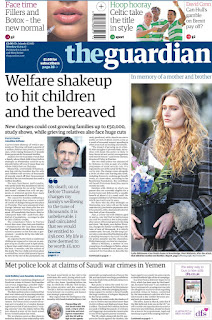The layout of newspapers follows a clear format. These typical elements such as a 'Masthead' and 'Splash' are known as the Codes and Conventions of newspaper layout and you need to name them all using accurate terminology. You will analyse newspapers as media products in your Media Messages exam.
Audience
Understanding the layout means you can immediately judge the content you expect to be reading in the product. There are two main types of newspapers Broadsheet and Tabloid and as a rule Broadsheet publications cover news stories in more depth, focusing on politics, economy and 'hard' news events, catering for an educated audience. Tabloids often include more 'soft' news such as celebrity stories and sensationalist language to appeal to a different demographic group. Broadsheet audiences are sometimes accredited with the tag 'information seekers' while Tabloid audiences are sometimes tagged 'emotional participants'.Format
A traditional quality broadsheet would use the layout below. These newspapers were printed on sheets of paper 116.83 x 86.28cm. In recent years newspapers that have traditionally used the broadsheet size have changed their format to cope with the rising costs of paper and newsprint. |
| A traditional Broadsheet format |
The Times and Independent have become tabloid size, while The Guardian has adopted a new Compact or Berliner format. As a result of such changes the terms 'broadsheet quality press' and the 'popular tabloid press' are now outdated terms. Some would argue that the quality press has become more like the popular or gutter press, a process known as tabloidisation.





Comments
Post a Comment